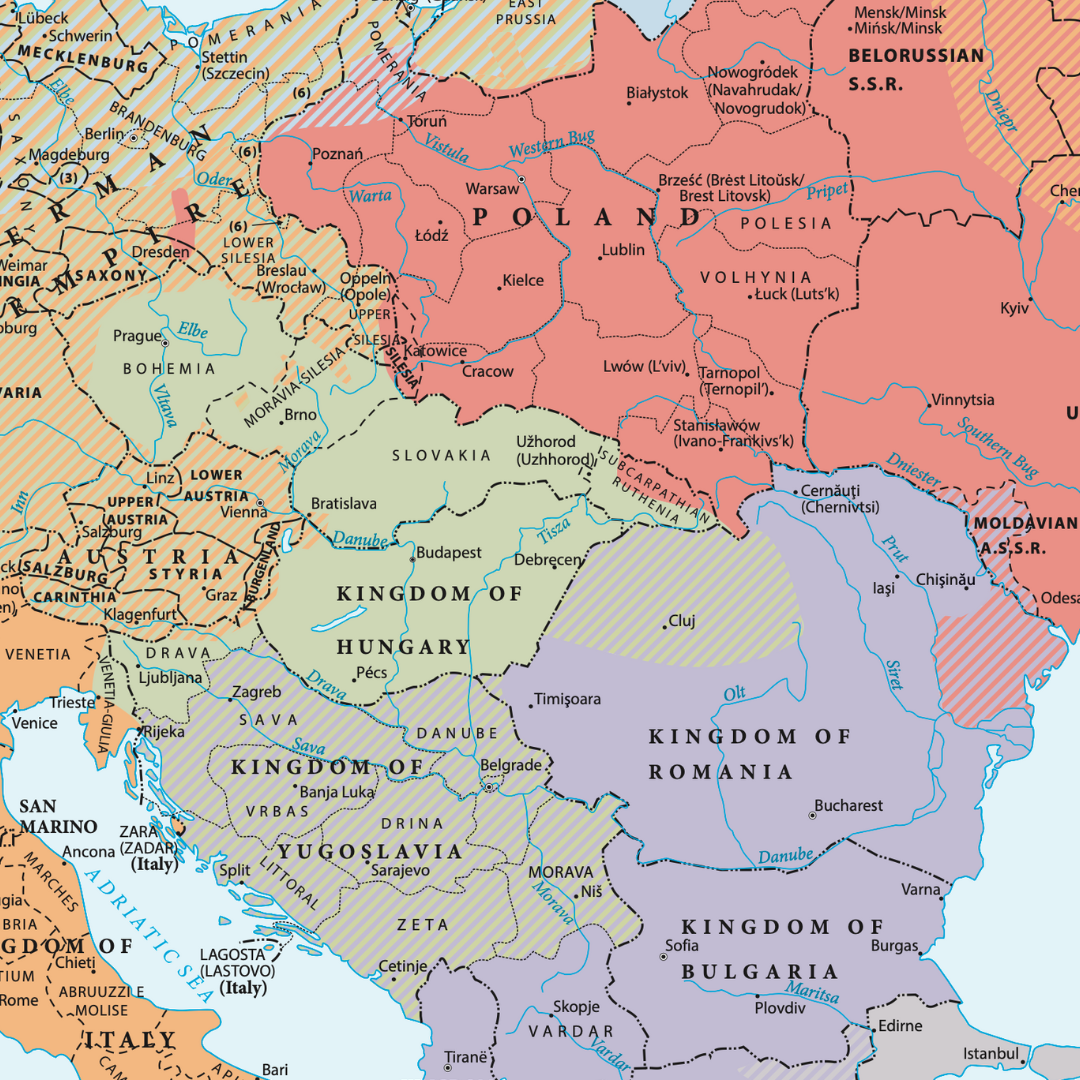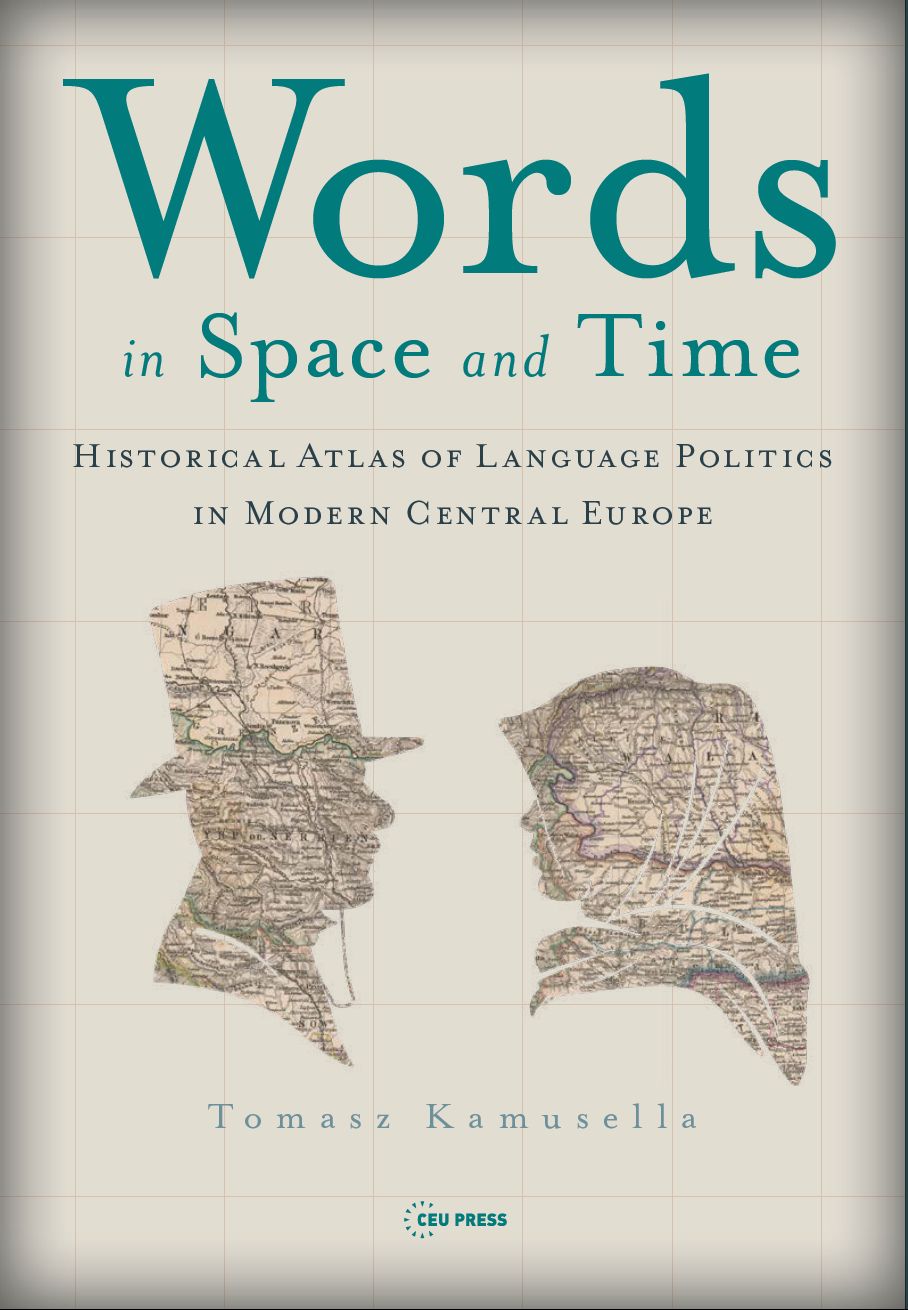Mapping language and nationalism in modern Central Europe
 Linguistic Areas (Sprachbünde) in Central Europe. From Kamusella, Words in Space and Time.
Linguistic Areas (Sprachbünde) in Central Europe. From Kamusella, Words in Space and Time. 
Published by: Central European University Press
 Linguistic Areas (Sprachbünde) in Central Europe. From Kamusella, Words in Space and Time.
Linguistic Areas (Sprachbünde) in Central Europe. From Kamusella, Words in Space and Time. Tomas Kamusella’s latest book contains 42 full-color maps with commentary, spread over 176 large pages. In the introduction (pp. xi, xvi) Kamusella claims to have drawn inspiration from Paul Robert Magocsi’s celebrated Historical Atlas of (East) Central Europe and presents the book as “a historical atlas of language politics”. The book is also supplemented with a 52-page glossary of various terms related to ethno-linguistic nationalism. Yet the book is not really a reference work: Kamusella presents a revisionist history of linguistic nationalism, and while his narrative focuses on East-Central Europe, he also discusses various developments in Central Asia, the Middle East, sub-Saharan Africa, and so forth. Chronologically, it begins in the ninth century, but devotes most of its attention to the age of nationalism, and particularly to the world wars. The results are sometimes idiosyncratic and repetitive, but overall thought-provoking, challenging, and persuasive.
To combat the terminological ambiguity that plagues scholarly discussions of linguistic nationalism, Kamusella rightly differentiates the analytical term “language”. He is also rightly skeptical of the language-dialect dichotomy. His analysis rests primarily on two analytical terms: the dialect continuum and the Einzelsprache.
The notion of a dialect continuum, while well-established, rarely features so prominently in historical narratives or ethnolinguistic cartography. Several early maps depict dialect continua before the age of nationalism (“Ninth century”, “c. 1050”, “c. 1570”) in which the varieties spoken by European peasants are grouped only into broad categories such as Slavic, Germanic, Finno-Ugric, Romance, or Baltic. Even when the narrative reaches 1910, however, Kamusella’s maps still employ a single color for “Germanic,” stretching from Scandinavia to the Alps, or for “North Slavic”, stretching from Prague to Warsaw, Minsk, Kyiv, and Moscow.
Insofar as, say, Slovene and Bulgarian enjoy a distinct status within, say, the South Slavic dialect continuum, Kamusella employs the German term Einzelsprache (p. 5 and pp. 189-90) His definition links the term to a dichotomy some Anglophone scholars have drawn between ‘a language’, the countable noun with indefinite article, and uncountable “language” without an article. Kamusella suggests that Einzelsprachen arise from the technology of writing, and several maps trace the development of writing systems, education systems, government-sponsored literacy campaigns, and the like. As Einzelsprachen proliferate, dialect continua are partitioned into discrete units, within which mass literacy and education generate certain pressures to homogenize.
Nowadays, it seems, all scholars must ritualistically genuflect before the idol of “diversity”, whether with conviction or without. Kamusella, however, is a true believer
The ethnic cleansing, suffering, and death resulting from dreams of ethnolinguistic homogeneity form the main theme of this book. Nowadays, it seems, all scholars must ritualistically genuflect before the idol of “diversity”, whether with conviction or without. Kamusella, however, is a true believer: the narrative often reads as a eulogy for the multilingualism and cosmopolitanism that once characterized East-Central Europe. Seven of the maps are devoted to ethnic cleansing in different historical periods (“Before the Balkan Wars”, “During the Balkan Wars, World War One, and in the Aftermath”, “During the 1930s”, “During World War Two, 1939-1940”, “During World War Two, 1940-1944”, “After World War Two, 1945-50”, and “During the Cold War, 1951-1989”). Kamusella strives for comprehensiveness, particularly drawing attention to expropriations and expulsions that have attracted less attention, such as, for example, the expulsion of Muslim “Turks” from Bulgaria.
Kamusella’s primary argument, however, is that these bouts of ethnic cleansing arise from an underlying cause: an ideology he calls “the normative isomorphism of language, nation and state” (see, p. 212). Kamusella sometimes summarizes normative isomorphism with the “handy algebraic-like equation language = nation = state” (p. xvi), but formally defines it as follows:
“When an ethnolinguistic nation-state A has … been successfully founded, its sole national language must be the national language A. The national language in question must be also unique, meaning that it may not be shared with any other nation or polity. In addition, should any autonomous entities be proclaimed within the boundaries of nation-state A, no other languages but the national language A should be allowed in such territorial autonomies. By the same token, language A should not be employed in any official function in autonomous regions located in other polities.” (p. 66)
The volume as a whole traces the uneven spread of normative isomorphism, often employing somewhat technical criteria based on administrative practices. For example, the fact that postwar Yugoslavia granted some official status to Albanian, Hungarian and Romanian, in Kamusella’s view “nullified the full isomorphic status of Albania, Hungary, and Romania” (131). In the interwar period, by contrast, the autonomous Soviet Socialist Republic of Moldova did not deprive Romania of its normative isomorphism because “the Soviet authorities dubbed the autonomous republic’s Cyrillic-based ethnic Einzelsprache ‘Moldovan’ in order to distance it from Romania’s national and official language of Romanian.” (p. 109)
[…] noting that recent years have witnessed both the continued vitality of normative isomorphism and the rise of populism, he anticipates further “war, ethnic cleansing and genocide around the corner”
Kamusella’s effervescent prose somewhat conceals the depth of his loathing for normative isomorphism. Toward the end of the book, however, noting that recent years have witnessed both the continued vitality of normative isomorphism and the rise of populism, he anticipates further “war, ethnic cleansing and genocide around the corner”, adding with sadness that he would “like to be mistaken” (p. 150). The book apparently went to press in November 2020 and was published in 2021. As I review the book in August 2022, during the sixth month of Russia’s war in Ukraine, I cannot but find this prediction depressingly prescient.
Kamusella’s affection for and interest in diversity also inspired a series of maps depicting East-Central Europe in various stateless languages of the region, several introduced by guest experts. There are maps in Latin, Ottoman Turkish, Yiddish, Esperanto, Moldovan, and Kamusella’s own native Silesian. Another striking map lists minority and unrecognized languages, intriguingly measuring their vitality partly through the number of Wikipedia articles in that language. These maps further the book’s main theme by illustrating and celebrating the region’s ethnolinguistic diversity. However, they also interrupt the flow of the main narrative about normative isomorphism and its terrible consequences.
The book has faults. The maps themselves are often hard to understand; explanatory text on map legends often appears in miniscule typeface, and occasionally in a faint color as well, for example, the “North Slavic” entries on page 95. Unusually for an atlas, the text is more interesting and valuable than the maps themselves. I also found myself unpersuaded and distracted by two chapters on “linguistic areas (Sprachbünde)”, evidently included to problematize the family tree model of linguistic diffusion.
Nevertheless, the volume takes many of the lessons in Kamusella’s exhaustive 2009 Politics of Language and Nationalism in Modern Central Europe and condenses them into a much more readable overview. The book distills a distinguished career’s worth of contemplation about how to formulate and study linguistic nationalism, combining insight with a humanistic concern for the welfare and well-being of the many peoples of the region. The work rethinks the most fundamental assumptions of ethnolinguistic nationalism, such as what exactly is meant by the term ‘language’, and presents a historical narrative based on the novel analytical vocabulary. While the book may be too technical for non-expert readers, individual chapters may find their way into undergraduate courses. The text is nevertheless essential reading for serious scholars of ethnolinguistic nationalism.
Alexander Maxwell is associate professor of history at Victoria University in Wellington, New Zealand. He is the author of Choosing Slovakia, Patriots Against Fashion, and Everyday Nationalism in Hungary. He has published widely on nationalism theory, and has guest edited themed issues of the journals Nationalities Papers, Nationalism and Ethnic Politics, German Studies Review, Central Europe, and Nationalism, Memory, and Language Politics. He is interested in Habsburg Pan-Slavism, has published an annotated English translation of Jan Kollár’s essay on Slavic reciprocity, and is currently preparing an annotated translation of Jan Herkel’s Pan-Slav grammar. He has also published widely on linguistic nationalism and is currently preparing a monograph on the language-dialect dichotomy in government administration.

Words in Space and Time: Historical Atlas of Language Politics in Modern Central Europe
Published by: Central European University Press
